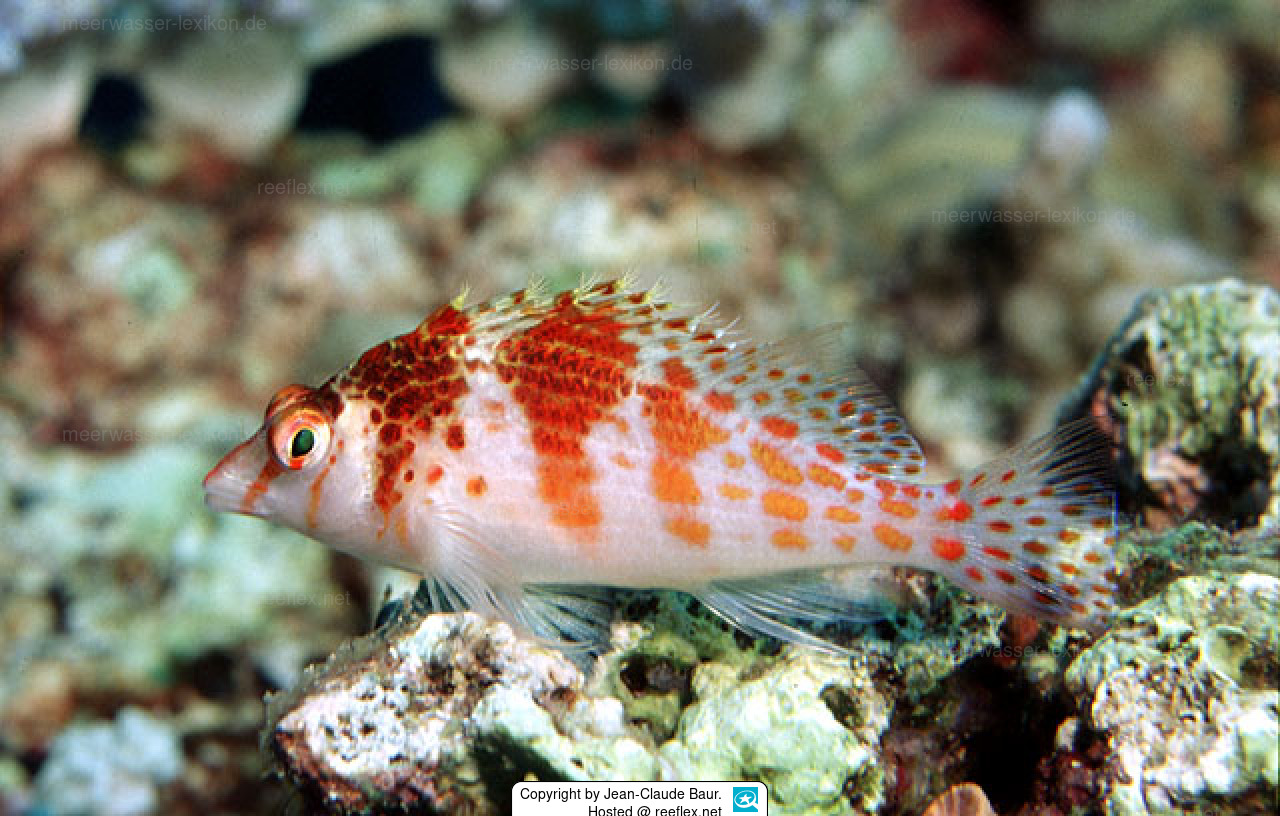Info
Cirrhitichthys falco Randall, 1963
Cirrhitichthys falco was first officially described in 1963 by American ichthyologist John Ernest Randall, with the type locality given as Davao Gulf, Mindanao in the Philippines. The specific name "falco" is Latin and means "falcon".
Randall did not explain the name, but it may be a reference to the common English name "hawkfish".
Shallow coastal to outer reef flats and slopes. Common inhabitant of coral reefs, typically resting at the base of coral heads. Harem, occasionally found in pairs, sometimes solitary. The spawn is released freely into the water.
Like many fish, this species can change sex. A dominant male keeps a harem of several females. If a harem becomes too large, one of the females may become the male and take over part of the harem as the dominant male. The special thing about this species is that the new male can return to the female if challenged by a stronger male. A male can become a female and successfully reproduce by laying fertile eggs
Keep like other coral guardians. Acclimatization usually causes hardly any problems. Not very aggressive towards other animals. Jumps easily at first, so seal the tank well.
Here is a partial scientific report on the harem behavior and aggressiveness of the females.
We investigated the territoriality and the territorial and mating relationships of the coral guardian, Cirrhitichthys falco on a reef off the island of Kuchierabu-jima in southern Japan. Each individual maintained a territorial home range, which was defended against conspecifics of the same sex at the boundary of the home range. The territory of each male included the territories of 2 - 3 females, allowing the male to completely monopolize mating opportunities with these females.
Based on our observations, we classified the harem type of Cirrhitichthys falco:
Large juveniles kept independent territories outside the female territories. In contrast, small juveniles were allowed to cohabit within the territory of an adult female. Analysis of stomach contents revealed that the smallest size class of Cirrhitichthys falco fed mainly on cephalopods. In contrast, all other size classes fed mainly on decapod crustaceans.
Taken together, these results suggest that the territoriality of females plays an important role in the defense of food resources.
Synonymised names
Cirrhitichthys serratus Randall, 1963 · unaccepted
Cirrhitichtys falco Randall, 1963 · unaccepted (misspelling)
Cirrtichthys falco Randall, 1963 · unaccepted > misspelling
Jumping guard
A jumping guard prevents (nocturnal) fish from jumping out.
Wrasses, blennies, hawkfishs and gobies jump out of an unprotected tank in fright if their night rest is disturbed, unfortunately these jumpers are found dried up in the morning on carpets, glass edges or later behind the tank.
https://www.korallenriff.de/en/article/1925_5_Jump_Protection_Solutions_for_Fish_in_the_Aquarium__5_Net_Covers.html
A small night light also helps, as it provides the fish with a means of orientation in the dark!
Cirrhitichthys falco was first officially described in 1963 by American ichthyologist John Ernest Randall, with the type locality given as Davao Gulf, Mindanao in the Philippines. The specific name "falco" is Latin and means "falcon".
Randall did not explain the name, but it may be a reference to the common English name "hawkfish".
Shallow coastal to outer reef flats and slopes. Common inhabitant of coral reefs, typically resting at the base of coral heads. Harem, occasionally found in pairs, sometimes solitary. The spawn is released freely into the water.
Like many fish, this species can change sex. A dominant male keeps a harem of several females. If a harem becomes too large, one of the females may become the male and take over part of the harem as the dominant male. The special thing about this species is that the new male can return to the female if challenged by a stronger male. A male can become a female and successfully reproduce by laying fertile eggs
Keep like other coral guardians. Acclimatization usually causes hardly any problems. Not very aggressive towards other animals. Jumps easily at first, so seal the tank well.
Here is a partial scientific report on the harem behavior and aggressiveness of the females.
We investigated the territoriality and the territorial and mating relationships of the coral guardian, Cirrhitichthys falco on a reef off the island of Kuchierabu-jima in southern Japan. Each individual maintained a territorial home range, which was defended against conspecifics of the same sex at the boundary of the home range. The territory of each male included the territories of 2 - 3 females, allowing the male to completely monopolize mating opportunities with these females.
Based on our observations, we classified the harem type of Cirrhitichthys falco:
Large juveniles kept independent territories outside the female territories. In contrast, small juveniles were allowed to cohabit within the territory of an adult female. Analysis of stomach contents revealed that the smallest size class of Cirrhitichthys falco fed mainly on cephalopods. In contrast, all other size classes fed mainly on decapod crustaceans.
Taken together, these results suggest that the territoriality of females plays an important role in the defense of food resources.
Synonymised names
Cirrhitichthys serratus Randall, 1963 · unaccepted
Cirrhitichtys falco Randall, 1963 · unaccepted (misspelling)
Cirrtichthys falco Randall, 1963 · unaccepted > misspelling
Jumping guard
A jumping guard prevents (nocturnal) fish from jumping out.
Wrasses, blennies, hawkfishs and gobies jump out of an unprotected tank in fright if their night rest is disturbed, unfortunately these jumpers are found dried up in the morning on carpets, glass edges or later behind the tank.
https://www.korallenriff.de/en/article/1925_5_Jump_Protection_Solutions_for_Fish_in_the_Aquarium__5_Net_Covers.html
A small night light also helps, as it provides the fish with a means of orientation in the dark!







 Jean-Claude Baur, Marokko
Jean-Claude Baur, Marokko



















